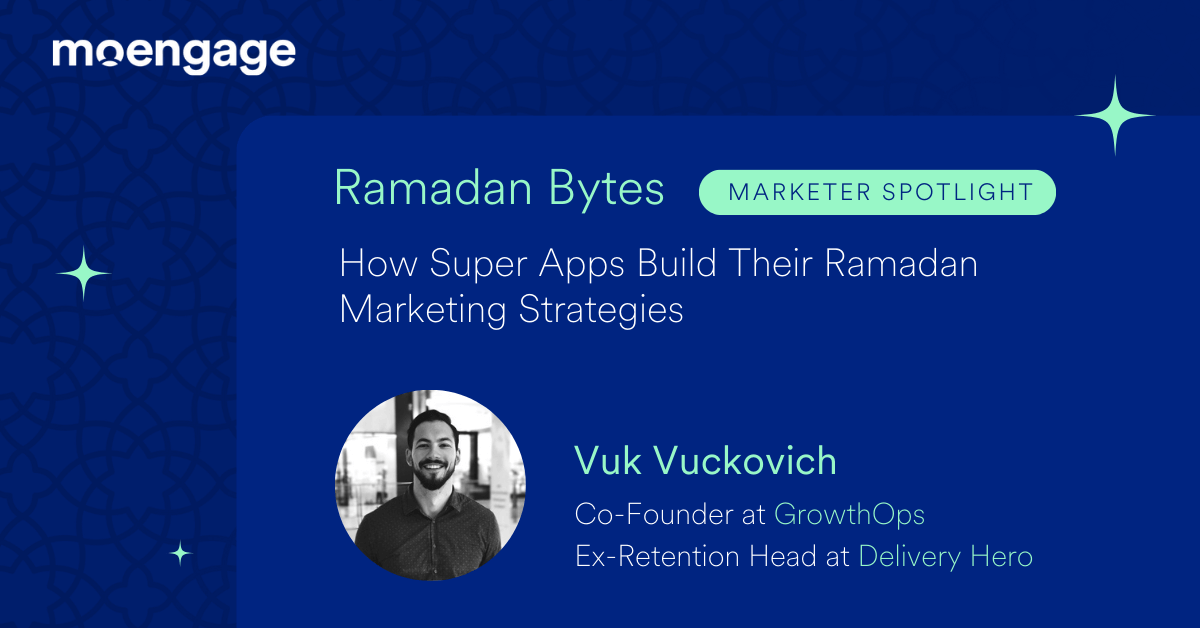How Super Apps Build Their Ramadan Marketing Strategies

Reading Time: 4 minutes
Editor’s Note: In 2023, we spoke to several B2C marketers about Ramadan marketing campaigns and how different industries try to maximize engagement this time of the year.
Back by popular demand from marketers (and product owners), we’re continuing Ramadan Bytes 2.0 in 2024!
Our first guest for this edition is Vuk Vukovich, Co-Founder at GrowthOps and Ex-Retention Head at Delivery Hero. In our deep dive, Vuk addressed customer engagement during Ramadan and how brands can use customer data to build successful marketing campaigns.
In this blog, we’ll try to distill his insights into bite-sized, consumable content for all marketers (and product owners) to emulate this Ramadan season!
Brief Introduction About Vuk
Vuk has extensive experience in CRM martech, having worked with companies like Careem and Delivery Hero to help them understand their customers and improve retention. He specializes in optimizing investments and generating high returns. Now, as founder of GrowthOps, he extends all that expertise to other businesses, mostly through CRM and marketing consulting.
How Brands Plan for Occasions Like Ramadan
He believes that personalization and understanding the target audience are crucial in marketing efforts. This is particularly important during major holidays like Ramadan, where observing patterns such as shopping behavior can provide valuable insights. Vuk also emphasized on the significance of spikes in activity, noting that anyone familiar with the Middle East would recognize a specific time when customers receive numerous notifications from apps. Utilizing these insights, he advises brands to optimize their communication strategies based on preferences.
| When it comes to a big holiday season, especially Ramadan, there are a couple of things to pay attention to, right? First of all, the shopping patterns are completely different. This can be observed by leveraging patterns and the way customers behave. |
How Brands Like Careem and Talabat Engage with Customers
According to Vuk, in case of Careem or Delivery Hero, or any other delivery food companies, the first step while preparing a campaign is – identifying the construct of the campaign:
-
- Who is the target audience?
- What is the right customer base?
- What are the objectives of the campaign?
The second consideration is whether and how to provide the best personalization to customers. This involves analyzing the type of communication and visuals to be used. For example, during Ramadan, visuals reflecting empathy, gathering, and togetherness can be utilized.
And, the final aspect is developing a seamless journey for the customer base. By understanding the preferred time and messages that customers respond to, a campaign can be crafted to increase customer lifetime value.
Super Apps Upselling and Cross-Selling Using Data
Vuk believes that strong data practices are an essential element for success.
| It is crucial to ensure proper structuring of data flows and utilize data modeling and behavior science to obtain optimal outcomes. |
When it comes to Super Apps, the usage patterns differ for each offering. For example, the frequency of eating versus ride-hailing may vary. Therefore, it is important to assess the likelihood of a customer performing a specific action. To achieve this, various techniques, such as predictive models, can be employed. These models score each customer based on their likelihood of engaging in a particular service within a given time period. This enables brands to identify cohorts and provide relevant offerings accordingly.
Role Played by Martech Stack in Engaging Customers During and After Ramadan
When it comes to marketing stacks, Vuk opines that it is important to determine whether to build certain components in-house or acquire them. He emphasizes that this decision is not necessarily an “either/or” choice but can be an “and” approach. Furthermore, he highlights the existence of various martech providers, such as MoEngage, that offer excellent technology and systems.
From a brand’s perspective, it is crucial to analyze the specific technology needed based on the stage of the business.
For example, a Customer Data Platform (CDP) can enhance data enrichment and provide flexibility in building and synchronizing data. And when it comes to building on top of that CDP, like communication channels, database segmentation flexibility, and the ability to create advanced communication flows, this is where Customer Engagement Platforms (CEPs) like MoEngage come into play.
| Still not sure whether to build or buy your customer engagement platform? Checkout our latest buyer’s guide, which deep-dives into the hidden costs of building a platform. |
Retaining Customers After a Holiday Season?
The key to maintaining momentum after big events or seasons like Ramadan is for brands to focus on smaller content beyond these ‘hero events’. The ultimate goal is to stay on top of customers’ minds through a layered communication strategy. The bottom layer of the strategy is continuous communication, which is often handled by CRM marketers. By understanding customer data and behaviors, these marketers can create relevant offers and effectively communicate with customers when they need it.
Another important factor is that successful brands that handle CRM and growth marketing well are the ones that can preemptively provide customers with what they need. This is not a strategy that delivers quick results, but it is a long-term approach that can help sustain momentum after large events or festive seasons. When the season is over, consumers will look to save money, and it is at this time that they will turn to brands that are at the forefront of their minds and offer what they need.
| Trying to build your calendar plan for this Ramadan Season? Check out our latest comic book that highlights the journey of three marketers and also has a 30 day calendar view, especially curated for you! |
Ready to Win Big During Ramadan?
Marketers should follow the story that data tells. Even for campaigns that worked like a year ago, for example – cart abandonment, today there is a higher need for hyper-personalization. This is what is going to differentiate a brand from the others, specially during a time like Ramadan and even after Ramadan.
In this cluttered environment, a notification or a message can only stand out if it addresses the needs of the customer. This can only happen when brands focus on the entire range of personalization that can be done – starting from geolocation to accurately identifying the best time to communicate.
Readers, you can connect with Vuk for more tips and advice on customer engagement during Ramadan and how to stay on top of customer’s minds.













